How to Control Myopia?

”What are the treatment options for managing myopia?”

Specialty Spectacle Lenses

OK
Lenses

Soft
Contacts

Low-dose
Atropine

Combined Treatment
DIMS Lenses

Defocus Incorporated Multiple Segments (DIMS) technology is the first to adopt lens array design to control myopia. The lenses comprise hundreds of small lenslet surrounding the central zone. The central optical zone provides a clear vision, while the surrounding lens array focus peripheral light rays in the front of the retina, resulting in defocused images. This multiple defocused segment halts the eyeball elongation through a physiological feedback mechanism. A randomized clinical trial proved that the lenses could effectively slow down myopia progression and axial elongation in the first two years, with the effect maintained in the third year.
- A 2-year double-blind randomized clinical trial
- 160 participants
- Slowed down eyeball elongation by 62%
- Reduced myopia progression by 52%
Lam, C. S. Y., Tang, W. C., Tse, D. Y. Y., Lee, R. P. K., Chun, R. K. M., Hasegawa, K., … & To, C. H.
(2020). Defocus Incorporated Multiple Segments (DIMS) spectacle lenses slow myopia progression: a 2-year randomised clinical trial. British Journal of Ophthalmology, 104(3), 363-368.
Lam, C. S., Tang, W. C., Lee, P. H., Zhang, H. Y., Qi, H., Hasegawa, K., & To, C. H. (2021). Myopia control effect of defocus incorporated multiple segments (DIMS) spectacle lens in Chinese children: results of a 3-year follow-up study. British Journal of Ophthalmology.

H.A.L.T. Lenses

Highly Aspherical Lenslet Target (H.A.L.T.) technology is a variant of lens array design. These lenses correct refractive errors by imposing peripheral defocuses simultaneously through the highly aspheric lenslets arranged in 11 surrounding concentric rings. A randomized clinical trial proved that the lenses could effectively slow down myopia progression and axial elongation in the first year.
-
A 2-year double-blind randomized clinical trial
- 157 participants
-
Overall slowed down eyeball elongation by 51%
(Up to 60% if worn for at least 12 hours a day) -
Reduce myopia progression by 55%
(Up to 67% if worn for at least 12 hours a day)
Bao J, Huang Y, Li X, et al. Spectacle Lenses With Aspherical Lenslets for Myopia Control vs Single-Vision Spectacle Lenses: A Randomized Clinical Trial. JAMA Ophthalmol. Published online March 31, 2022. doi:10.1001/jamaophthalmol.2022.0401
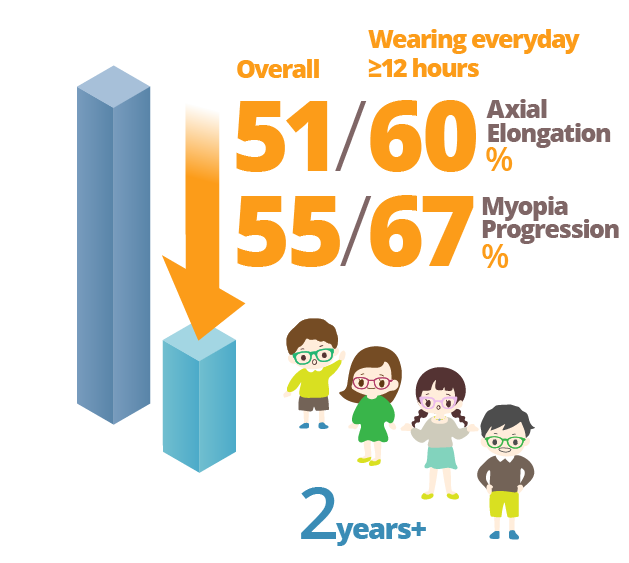
Executive Bifocal Lenses

Executive Bifocal Lenses are lenses with two different optical portions. The upper portion provides the far power for distance viewing and the lower portion provides the near power for looking up close. Prism design can also be added to these lenses (prism bifocal lenses).
Compared with the control group wearing single vision lenses, both the bifocal and prism bifocal groups reduce axial elongation. The bottom portion of the bifocal lenses reduce the workload of the eyes to focus at nearby. It controls children’s myopia by lowering reading and near-work focusing demands.
- A 3-year randomized clinical trial
- 135 participants
- Slowed down eyeball elongation by 39% (without prism) and 51% (with prism)
- Reduced myopia progression by 30% (without prism) and 34% (with prism)
Cheng, D., Woo, G. C., Drobe, B., & Schmid, K. L. (2014). Effect of bifocal and prismatic bifocal spectacles on myopia progression in children: three-year results of a randomized clinical trial. JAMA ophthalmology, 132(3), 258-264.
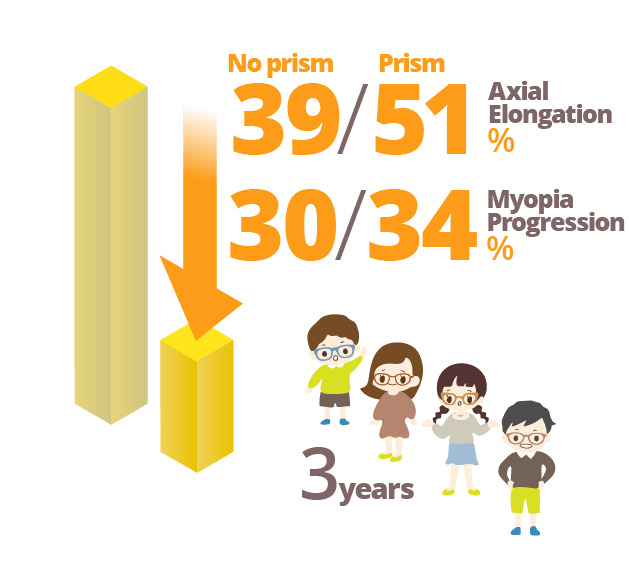
PALS Lenses

Similar to the bifocal lenses, the bottom portion of the Progressive Addition Lenses (PALS) reduces near-work focusing demands, but its myopia control efficiency is relatively poor.
- A 3-year randomized clinical trial
- 469 participants
- Slowed down eyeball elongation by 15%
- Reduced myopia progression by 14%
Correction of Myopia Evaluation Trial 2 Study Group for the Pediatric Eye Disease Investigator Group. (2011). Progressive-addition lenses versus single-vision lenses for slowing progression of myopia in children with high accommodative lag and near esophoria. Investigative ophthalmology & visual science, 52(5), 2749-2757.
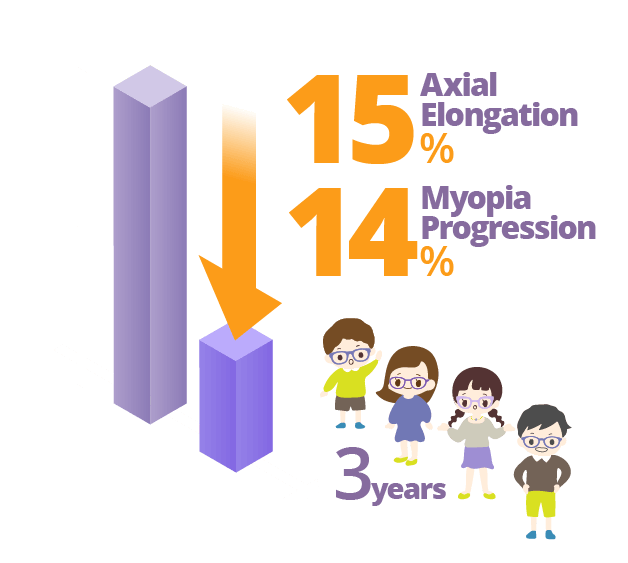
Peripheral Hyperopia Reduction Lenses

The modified aspheric lenses design are designed to adjust the optical defocus profile on the peripheral retina. A 12-month randomized controlled clinical trial in 2010 revealed a myopia control effectiveness up to about 30%. However, a recent 24-month randomized clinical trial on 207 participants found that this lens design did not have a clinically significant effect in slowing down axial elongation or myopia progression.
OK Lenses

- Slowed down eyeball elongation by about 43% - 63%
Cho, P., & Cheung, S. W. (2012). Retardation of myopia in Orthokeratology (ROMIO) study: a 2-year randomized clinical trial. Investigative ophthalmology & visual science, 53(11), 7077-7085.
Cho, P., Cheung, S. W., & Edwards, M. (2005). The longitudinal orthokeratology research in children (LORIC) in Hong Kong: a pilot study on refractive changes and myopic control. Current eye research, 30(1), 71-80.
Walline, J. J., Jones, L. A., & Sinnott, L. T. (2009). Corneal reshaping and myopia progression. British Journal of Ophthalmology, 93(9), 1181-1185.
Charm, J., & Cho, P. (2013). High myopia–partial reduction ortho-k: a 2-year randomized study.
Optometry and Vision Science, 90(6), 530-539.
Si, J. K., Tang, K., Bi, H. S., Guo, D. D., Guo, J. G., & Wang, X. R. (2015). Orthokeratology for myopia control: a meta-analysis. Optometry and Vision Science, 92(3), 252-257.
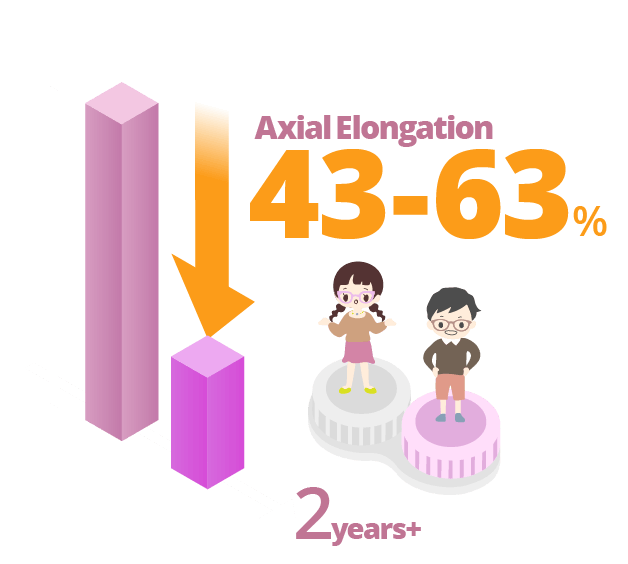
Soft Contacts

Soft Contacts (Dual-Focus Lenses) consist of different powered concentric rings for slowing down myopia progression. This method focusses an image in front of the retina, leading to myopic defocus, causing slower eye elongation by the feedback system of the retina. Also, this type of soft contact lenses can correct the vision and is suitable for daily wear. There are daily disposable and 3-months disposable available in the market. Proper lens care and hygiene are the crucial factors to avoid corneal infections. Ask your optometrist about soft myopia control contact lenses.
- 2-years and 3-years randomized clinical trials
- Daily wear of 8 hours or more
- Slowed down eye elongation by 52% - 58%
- Reduced myopia progression by 58% - 59%
Chamberlain, P., Peixoto-de-Matos, S. C., Logan, N. S., Ngo, C., Jones, D., & Young, G. (2019). A 3-year randomized clinical trial of MiSight lenses for myopia control. Optometry and Vision Science, 96(8), 556-567.
Chamberlain, P., Arumugam, B., & Jones, D. (2020). Myopia progression in children wearing dual-focus contact lenses: 6-year findings. Optom Vis Sci, 97, 200038.
Lam, C. S. Y., Tang, W. C., Tse, D. Y. Y., Tang, Y. Y., & To, C. H. (2014). Defocus Incorporated Soft Contact (DISC) lens slows myopia progression in Hong Kong Chinese schoolchildren: a 2-year randomised clinical trial. British Journal of Ophthalmology, 98(1), 40-45.
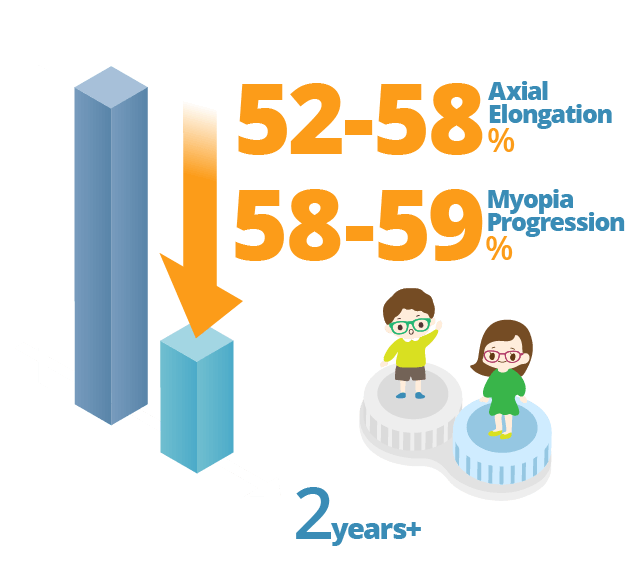
Low-dose
Atropine
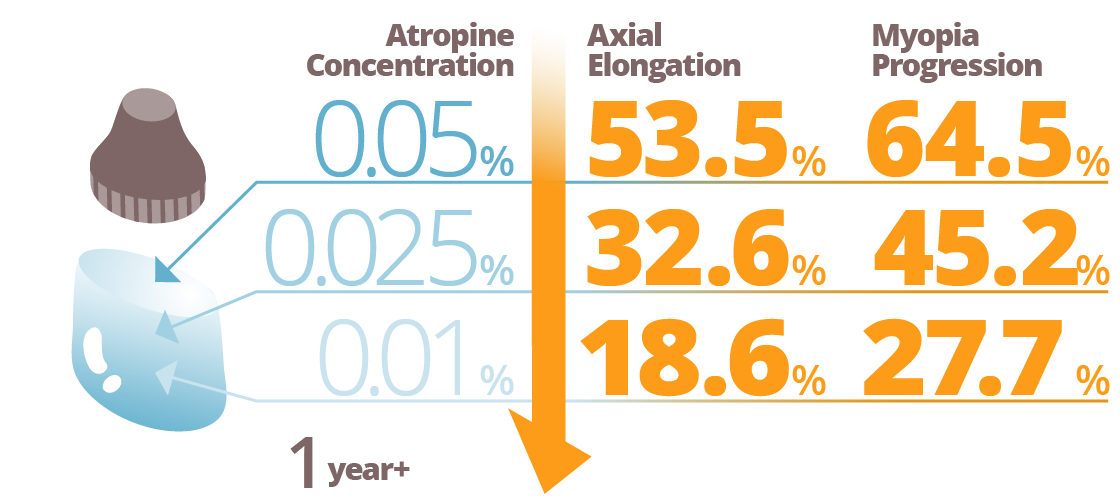
Low-dose (0.01% - 0.05%) of Atropine eye drops can be instilled one drop per day in each eye to slow down myopia progression. Spectacles or contact lenses are still needed to correct vision during the day. A clinical trial showed that it can effectively slow down myopia progression and elongation of the eyeball in the first year, and maintain its effect on the 2nd and 3rd year. The mechanism of atropine for myopia control is not yet clear.
The common side effect of using Atropine is sensitivity to light and difficulty in focusing at near vision. Both symptoms may affect near reading performance. A rebound effect has been reported upon cessation of Atropine for myopia control. Currently research is ongoing to evaluate the best dose to balance side effects and efficacy for controlling myopia progression.
- Randomized clinical trial longer than 1 year
- Atropine of 0.05%: Slowed down eyeball elongation by 53.5% and myopia progression by 64.5%
- Atropine of 0.025%: Slowed down eyeball elongation by 32.6% and myopia progression by 45.2%
- Atropine of 0.01%: Slowed down eyeball elongation by 18.6% and myopia progression by 27.7%
Yam, J. C., Li, F. F., Zhang, X., Tang, S. M., Yip, B. H., Kam, K. W., … & Pang, C. P. (2020). Two-year clinical trial of the low-concentration atropine for myopia progression (LAMP) study: phase 2 report. Ophthalmology, 127(7), 910-919.

Combined Treatment

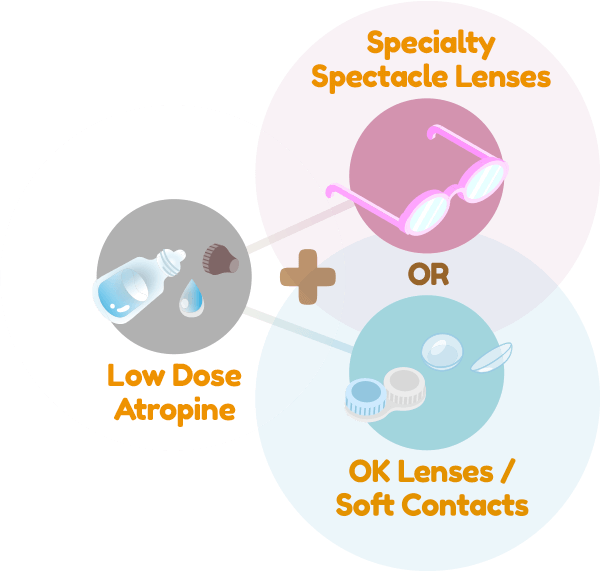
For most children, a single treatment is sufficient to control myopia progress. However, when myopia continue to progressive significantly, combined treatment with Atropine and optical method are considered. Please consult your optometrist or ophthalmologist for combined treatment.
Up to August 2021, there are several clinical studies indicating that combining Atropine with ortho-K potentially help to increase myopia control efficacy. While clinical trial for combining atropine with other myopia control spectacles lenses are still ongoing.
Kinoshita, N., Konno, Y., Hamada, N., Kanda, Y., Shimmura-Tomita, M., Kaburaki, T., & Kakehashi, A. (2020). Efficacy of combined orthokeratology and 0.01% atropine solution for slowing axial elongation in children with myopia: a 2-year randomised trial. Scientific Reports, 10(1), 1-11.
Tan, Q., Ng, A. L., Choy, B. N., Cheng, G. P., Woo, V. C., & Cho, P. (2020). One‐year results of 0.01% atropine with orthokeratology (AOK) study: a randomised clinical trial. Ophthalmic and Physiological Optics, 40(5), 557-566.




